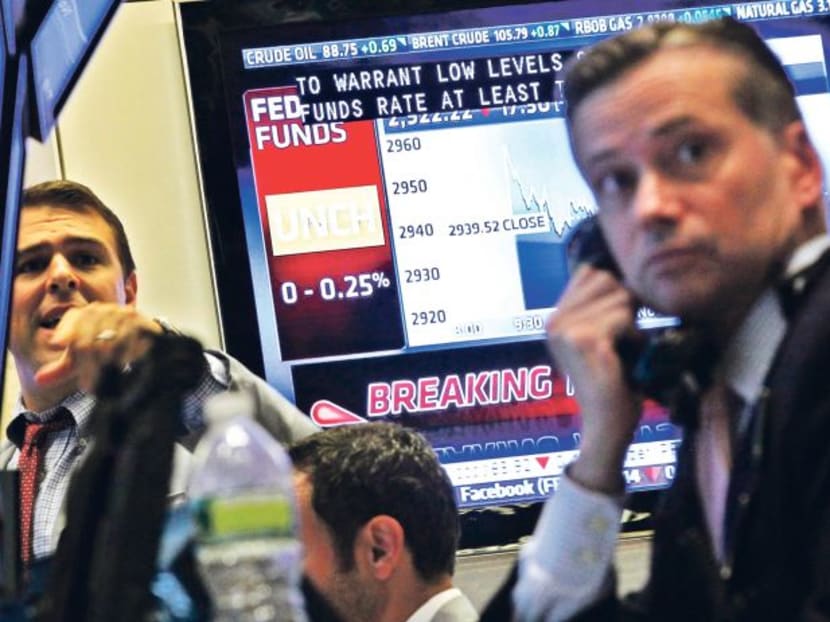Recent volatility unlikely to alter Fed’s course
WASHINGTON — The United States Federal Reserve is expected to maintain its current course of monetary policy despite recent market gyrations, various Fed officials have said in recent comments.

Traders on the floor of the New York Stock Exchange. US stocks had one of their most volatile five days since the financial crisis, with the Standard & Poor’s 500 Index ending last week down 6.2 per cent from the record high last month. Photo: REUTERS
WASHINGTON — The United States Federal Reserve is expected to maintain its current course of monetary policy despite recent market gyrations, various Fed officials have said in recent comments.
The central bank still intends to finish its bond-buying campaign at the end of the month and is still likely to start raising interest rates in the middle of next year, although it now seems more likely that the Fed will wait longer.
In an interview over the weekend, Boston Fed president Eric Rosengren said the central bank should not overreact to turmoil in financial markets, as it approaches its next policy-making meeting at the end of the month.
While it would take a few more weeks to understand the real economic fallout from the market sell-off, Mr Rosengren could “easily imagine” a scenario in which the Fed keeps rates near zero until 2016.
“Patient monetary policy probably makes sense … Certainly, the events of the past couple of weeks probably give credence to thinking about being patient and trying to process some of the movements we’re seeing,” he said.
US stocks had one of their most volatile five days since the financial crisis, with the Standard & Poor’s 500 Index ending last week down 6.2 per cent from the record high last month.
The turmoil began not long after minutes of last month’s Federal Open Market Committee meeting, released on Oct 8, showed members had growing concerns over slowing global growth.
Mr Rosengren and other Fed officials have said it is possible that market gyrations and a downturn in inflation expectations are early indications that they have again overestimated the recovery. However, the bulk of recent data has been more upbeat and they see little harm in waiting for more information.
The Fed has methodically pulled back from bond-buying over the past nine months. It plans to add a final US$15 billion (S$19 billion) in Treasury and mortgage-backed securities this month. Officials have pointed to the steady decline of the unemployment rate as proof that the economy no longer needs quite as much help.
In recent weeks, however, market measures of inflation expectations have fallen sharply. On Friday, a measure called the break-even rate, which is derived from asset prices, implied that annual inflation would run at around 1.37 per cent over the next five years.
The decline may show investors have growing doubts that the Fed will meet its stated target of 2 per cent annual inflation.
San Francisco Fed president John Williams said in an interview last week that, if the central bank did decide more stimulus was needed, he would prefer to respond first by delaying interest-rate increases.
That view is shared by most Fed officials, Mr Michael Feroli, chief US economist at JPMorgan Chase, wrote last week.
However, some Fed officials are concerned that the central bank risks waiting for too long before starting to raise interest rates. In a recent interview, Cleveland Fed president Loretta Mester pointed to research by her staff that found that unemployment had “almost” returned to a normal level, based on an analysis of five measuresof labour market slack. “They’re all basically showing we’re getting close to our goal in terms of slack being reduced. That’s significant,” she said.
Ms Mester added that she was “not too disturbed” by the persistence of sluggish inflation, saying she still expected inflation to return to the Fed’s 2 per cent target, but that “inflation is a gradual process”.
However, other officials have argued with increasing vigour in recent weeks that the greater risk is premature retreat.
Minneapolis Fed president Narayana Kocherlakota has been the most outspoken. He reiterated in a speech on Thursday that the Fed should forswear rate increases until officials are convinced inflation would reach their 2 per cent target in two years.
He said it was therefore “inappropriate” to raise rates next year, unless economic conditions change.
Chicago Fed president Charles Evans has made a similar case less pointedly. “I feel that before the Fed raises rates, we should have a great deal of confidence that we won’t be forced to backtrack on our moves,” he told an audience in Indianapolis last week. “We should be exceptionally patient in adjusting the stance of US monetary policy.” Agencies





